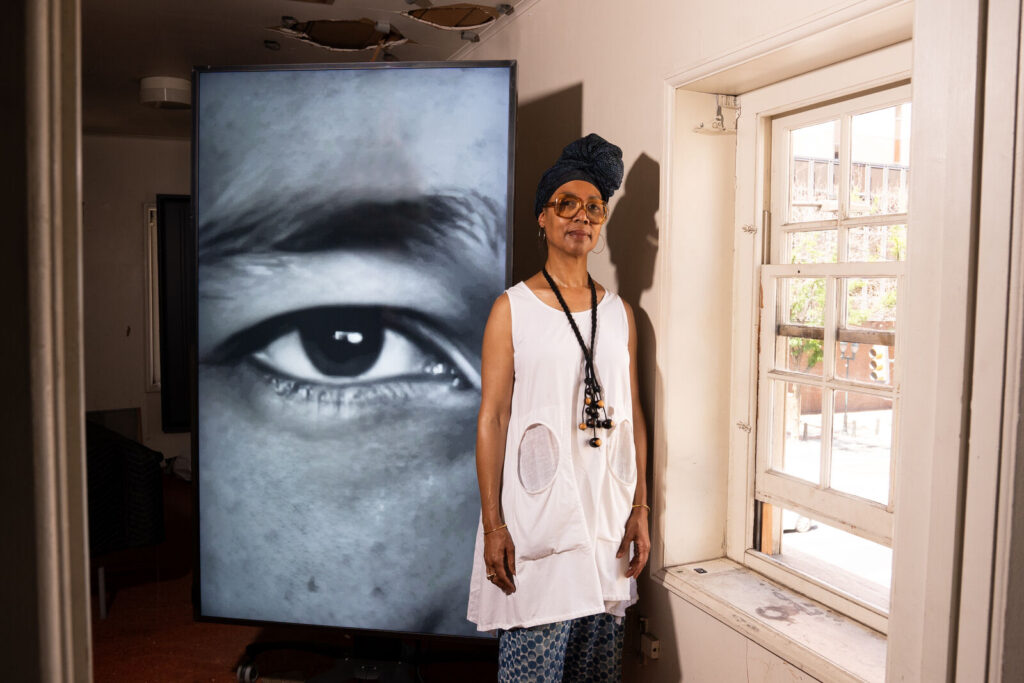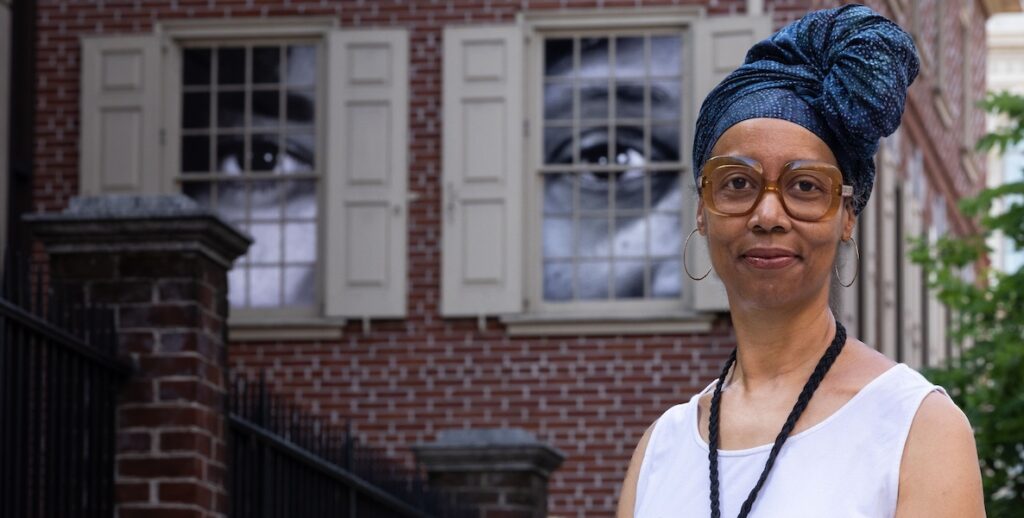Most Philadelphians will know, and Independence National Historic Park is happy to remind you, that the Declaration of Independence was drafted right here in our city. In the spring of 1776, founding father Thomas Jefferson rented a home at 7th and Market and wrote a document that changed the course of human history by declaring universal principles of freedom and liberty. Also with him at that house was Robert Hemmings, whom Jefferson enslaved.
Today at that same site, Declaration House is a strange extension of Independence National Historic Park. The building was constructed in the 1970s as a recreation of the home Jefferson and Hemmings stayed in, but it is currently closed to the public. It’s just there. Not historic itself, but a house-sized marker of what once was.
Lately, however, that has changed. Monument Lab, Independence National Historic Park, and artist Sonya Clark have brought new energy, and new stories, to the space with Declaration House, “a public art and history exhibition” centered on the debut of Clark’s video installation The Descendants of Monticello.
Clark, an artist known for her keen interest in American history, has filled the windows of Declaration House with videos of oversized eyes staring out onto the street below. Each eye belongs to a living descendent of someone who was enslaved at Monticello, including members of the Hemmings family and some of Jefferson’s own descendants. The piece complicates the Jeffersonian ideals that are usually the focus of the house and asks, “If Robert Hemmings could see America today, what would he think?”
The Descendants of Monticello runs 24/7 through December 1.
As part of a partnership with Forman Arts Initiative, the Citizen caught up with Clark. The interview has been condensed and edited for clarity.

RJ Rushmore: “The Descendants of Monticello” is such a complex and weighty work when you dig into it, but visually it’s quite straightforward: eyes. It’s an effective “in” for audiences. Where did the focus on eyes come from?
Sonya Clark: I’m working on another artwork where I am making something like evil eyes, those blue glass eyes meant to ward off evil. But I am working with the eyes of Black people who have been formidable in American culture. Everyone from Toni Morrison to Chadwick Boseman. I get images of those eyes, and then I encase those eyes behind glass and set them like stones in very tiny beadwork. It’s about protecting us through the eyes of cultural ancestors. Imagine hundreds of eyes looking at you. Hundreds and hundreds of them. It’s like, don’t mess with this many ancestors.
We don’t have any images of Robert Hemmings, because he was enslaved. Obviously, we have portraits of his enslaver — [who was] also his brother-in-law, Thomas Jefferson. But I thought about how Hemmings’ eyes live on in the eyes of his descendants, and I knew that he at least had collateral descendants because one of my dear friends, Gayle Jessup White, is the fifth great-granddaughter of Sally Hemmings and Thomas Jefferson. I thought that if I could go through her family’s photo albums to collect the eyes of collateral descendants of Robert Hemmings, we could find his eyes in their eyes.
But Gayle said to me, “I’ve got something better for you. We can do this with my family, but there’s also this Getting Word African American Oral History Project here at Monticello who are doing good work.” And so Paul Farber and I took a trip to Monticello, where we met Andrew Davenport, the director of Getting Word. Andrew asked if I was interested in expanding the project beyond the Hemings line. If I was, he said he could gather some people for us, living descendents. That opened up new possibilities.
How did the opportunity to document these eyes on video, eyes of living descendents, rather than sourcing family photos, inform the piece?
I really wanted this project to be art as a verb, and still eyes wouldn’t do that. These eyes, the eyes of living descendants of those who had been enslaved at Monticello by Jefferson, are watching. They’re moving. They’re seeing. They are looking. What are these eyes witnessing? Who are they seeing? They’re looking at you.
As people are standing on 7th and Market across the street from the Declaration House waiting for the bus, I hope they are watching the artwork that is watching them. And that engagement is the kind of engagement that I hope we have with the Declaration of Independence. What does it mean right now, where did it falter, and what needs to be corrected?
Here we have the paradox of America. The formation of this nation is rooted in a document drafted by Thomas Jefferson. Someone who enslaved around 600 people in his lifetime. A man who is not an abolitionist, who initially drafts a paragraph where he addresses slavery as a problem and it gets removed. A man who does all of these things in the name of freedom. Freedom for who? Toni Morrison said the purpose of freedom is to free somebody else. And if Thomas Jefferson had thought about that, or if we just held that in our hearts as a nation, we would be in a very different space from then to now.
Gathering these descendants and holding these portrait sessions must have been a very emotional process.
It was beautiful. When they looked right into the camera, they could see the reflection of their eyes in the camera lens. You’re seeing them looking at themselves. And I prompted them to think about their ancestral legacy, that in their eyes are the eyes of their ancestors as well.
How did your eventual audience at Declaration House inform the project?
I’m grateful to Monument Lab because this is my first large-scale public artwork. Nobody has to enter into a specific building or pay a fee. I’ve been making work for 30 years. This is the first opportunity I’ve had to make an artwork that engages such a broad audience.
How has that been different from a typical museum or gallery exhibition?
Whenever I visit the piece, I’m encountering the fact that this is a city and there are people who are suffering. So I’m encountering people who are unhomed, who are asking for change. I have had two brief conversations with people asking me for money outside of Declaration House. In those moments, I wonder what is it for the eyes of the enslaved, for the eyes of descendants of the enslaved, to see and be seen by people that this democracy has not been taken care of. The most vulnerable people in this democracy. We witness the work, the work witnesses us and what we are doing to and with each other.
What sort of responses are you hearing from visitors?
I wish I was standing on the corner all the time, because people’s responses lead to important critical questions.
One person asked me if the beings to whom the eyes belonged were trapped in the building. But these eyes are larger than life. You couldn’t possibly hold all these bodies in that house. The five-foot-tall eyes in the windows make the building look so small by comparison. And that, for me, becomes a metaphor. All of the marginalized communities that have been subjugated by this document, we are larger than that subjugation. So we need to claim our largeness, our monumentality. My sense was these eyes are so large, they’re coming at you large and in charge, so pay attention. What are you doing? How are you minding this democracy? The question of whether they seem trapped is the thing that generated those answers for me.
With this piece, it seems to me that Independence National Historic Park is telling a fuller story of America, something that complicates the default (White) narrative of a place like Declaration House. How do you see your role in that retelling?
There is that beautiful James Baldwin quote, “Nothing can be changed until it is faced.” And so I do hope in this artwork there is that, the facing of what must be changed.
RJ Rushmore is a writer, curator and public art advocate. He is the founder of the street art blog Vandalog and culture-jamming campaign Art in Ad Places. As a curator, he has collaborated with Poster House, Mural Arts Philadelphia, The L.I.S.A. Project NYC and Haverford College. Rushmore’s writing has appeared in Hyperallergic, Juxtapoz, Complex and numerous books. He holds a B.A. in Political Science from Haverford College, where his thesis investigated controversies in public art.
This story is part of a partnership between The Philadelphia Citizen and Forman Arts Initiative to highlight creatives in every neighborhood in Philadelphia. It will run on both The Citizen and FAI’s websites.

